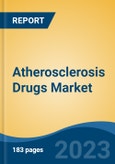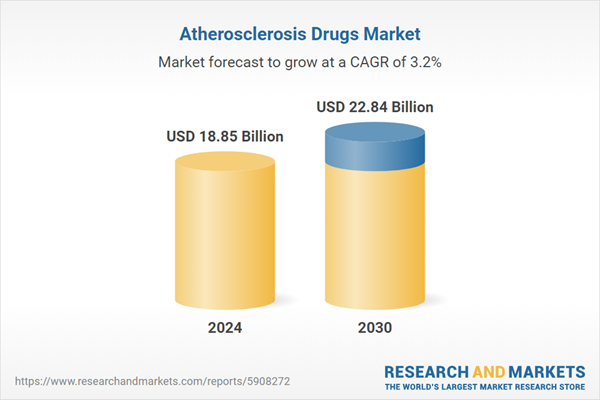Speak directly to the analyst to clarify any post sales queries you may have.
10% Free customizationThis report comes with 10% free customization, enabling you to add data that meets your specific business needs.
Unhealthy lifestyle factors such as poor diet, physical inactivity, and smoking are major contributors to the rising incidence of atherosclerosis worldwide, leading to a large patient population in need of treatment. Furthermore, the aging global population is at higher risk, which is expected to drive demand for atherosclerosis medications. Advances in medical technology and diagnostics have enabled earlier detection, facilitating more timely interventions and treatments. Public health campaigns and increasing awareness about cardiovascular health have also encouraged more individuals to seek treatment.
While the Global Atherosclerosis Drugs Market presents significant opportunities, it also faces challenges. With the rising burden of atherosclerosis, ongoing innovation and research are critical to developing effective therapies. Personalized medicine and targeted treatments show promise in improving patient outcomes. However, challenges related to drug pricing, patient adherence, and growing competition must be addressed to ensure accessibility for those in need. The collaboration between pharmaceutical companies, healthcare providers, and policymakers will be essential to combating atherosclerosis and its impact on global health.
Key Market Drivers
Rising Prevalence of Atherosclerosis
Atherosclerosis, characterized by plaque buildup in arteries, is becoming more widespread worldwide. This condition significantly increases the risk of heart attacks, strokes, and other cardiovascular diseases, making it a global healthcare priority. As modern lifestyles contribute to obesity, hypertension, and high cholesterol, the need for effective treatments for atherosclerosis is intensifying. Diets high in saturated fats, trans fats, and processed foods, common in many regions, further exacerbate the risk factors. Additionally, atherosclerosis is more prevalent in older individuals, and as the global population ages, the incidence of this condition is expected to rise, further stressing healthcare systems. Tobacco use and diabetes are also major contributors to the increasing prevalence of atherosclerosis.Recent research has uncovered cancer-like features in atherosclerosis, highlighting potential new treatment avenues. Studies supported by the National Institutes of Health (NIH) suggest that smooth muscle cells in arteries may take on characteristics similar to cancer cells, worsening the condition. This discovery opens the door for novel therapies, such as using anti-cancer drugs to target these tumor-like processes, offering hope for more effective treatments.
Key Market Challenges
Increasing Competition
The atherosclerosis drugs market is highly competitive, with numerous established pharmaceutical companies and emerging players vying for market share. Major pharmaceutical companies like Pfizer, AstraZeneca, and Merck have dominated the market for years, benefiting from blockbuster drugs such as Lipitor (atorvastatin) and Crestor (rosuvastatin). However, newer entrants are introducing innovative therapies and specialized drug formulations targeting different aspects of atherosclerosis treatment. These companies are focusing on niche areas such as LDL cholesterol reduction or inflammation to address unmet needs in the market.The rise of biosimilars and generics has further intensified competition, as these cost-effective alternatives to branded drugs become more prevalent. Smaller companies or startups face challenges related to regulatory approvals, clinical trials, and securing adequate funding. The dominance of established market leaders adds to the difficulty for newcomers to differentiate themselves. To remain competitive, companies must focus on innovation, whether through new drug formulations, strategic partnerships, or acquisitions.
Key Market Trends
Technological Advancements
Technological progress in healthcare is revolutionizing the development, diagnosis, and treatment of atherosclerosis, which is contributing to the growth of the market. Modern imaging technologies such as CT angiography, MRI, and intravascular ultrasound (IVUS) provide high-resolution images of blood vessels, enabling more accurate assessment of plaque buildup and its severity. Additionally, blood tests that incorporate biomarkers like high-sensitivity C-reactive protein (hs-CRP) and lipoprotein-associated phospholipase A2 (Lp-PLA2) aid in the early detection and risk assessment of atherosclerosis.Artificial intelligence (AI) and machine learning are also enhancing the diagnosis of atherosclerosis by analyzing medical imaging and patient data to identify patterns and predict disease progression. These advancements are improving both the accuracy and efficiency of diagnosing atherosclerosis, contributing to better patient outcomes.
Key Market Players
- F. Hoffmann-La Roche Ltd
- Novartis AG
- Merck & Co. Inc.
- Pfizer Inc.
- Eli Lilly and Co.
- Sanofi S.A.
- AstraZeneca Plc
- Bayer AG
- Regeneron Pharmaceuticals Inc.
- GSK Plc
Report Scope
This report segments the Global Atherosclerosis Drugs Market into the following categories:
- Diagnosis
- Ankle-brachial Index
- Doppler Ultrasound
- Echocardiogram
- Electrocardiogram
- Blood Tests
- Others
- Treatment
- Medication
- Surgery
- Others
- Route of Administration
- Oral
- Parenteral
- Others
- End User
- Hospitals & Clinics
- Ambulatory Care Centers
- Others
- Region
- North America
- United States
- Canada
- Mexico
- Europe
- France
- United Kingdom
- Italy
- Germany
- Spain
- Asia-Pacific
- China
- India
- Japan
- Australia
- South Korea
- South America
- Brazil
- Argentina
- Colombia
- Middle East & Africa
- South Africa
- Saudi Arabia
- UAE
Competitive Landscape
The report includes detailed profiles of major companies in the atherosclerosis drugs market, offering insights into their market strategies and financial performance.Available Customizations
The Global Atherosclerosis Drugs Market report can be customized to meet specific company needs, including detailed analysis and profiling of additional market players (up to five).This product will be delivered within 1-3 business days.
Table of Contents
Companies Mentioned
- F. Hoffmann-La Roche Ltd
- Novartis AG
- Merck & Co. Inc.
- Pfizer Inc.
- Eli Lilly and Co.
- Sanofi S.A.
- AstraZeneca Plc
- Bayer AG
- Regeneron Pharmaceuticals Inc.
- GSK Plc
Table Information
| Report Attribute | Details |
|---|---|
| No. of Pages | 185 |
| Published | February 2025 |
| Forecast Period | 2024 - 2030 |
| Estimated Market Value ( USD | $ 18.85 Billion |
| Forecasted Market Value ( USD | $ 22.84 Billion |
| Compound Annual Growth Rate | 3.2% |
| Regions Covered | Global |
| No. of Companies Mentioned | 10 |









